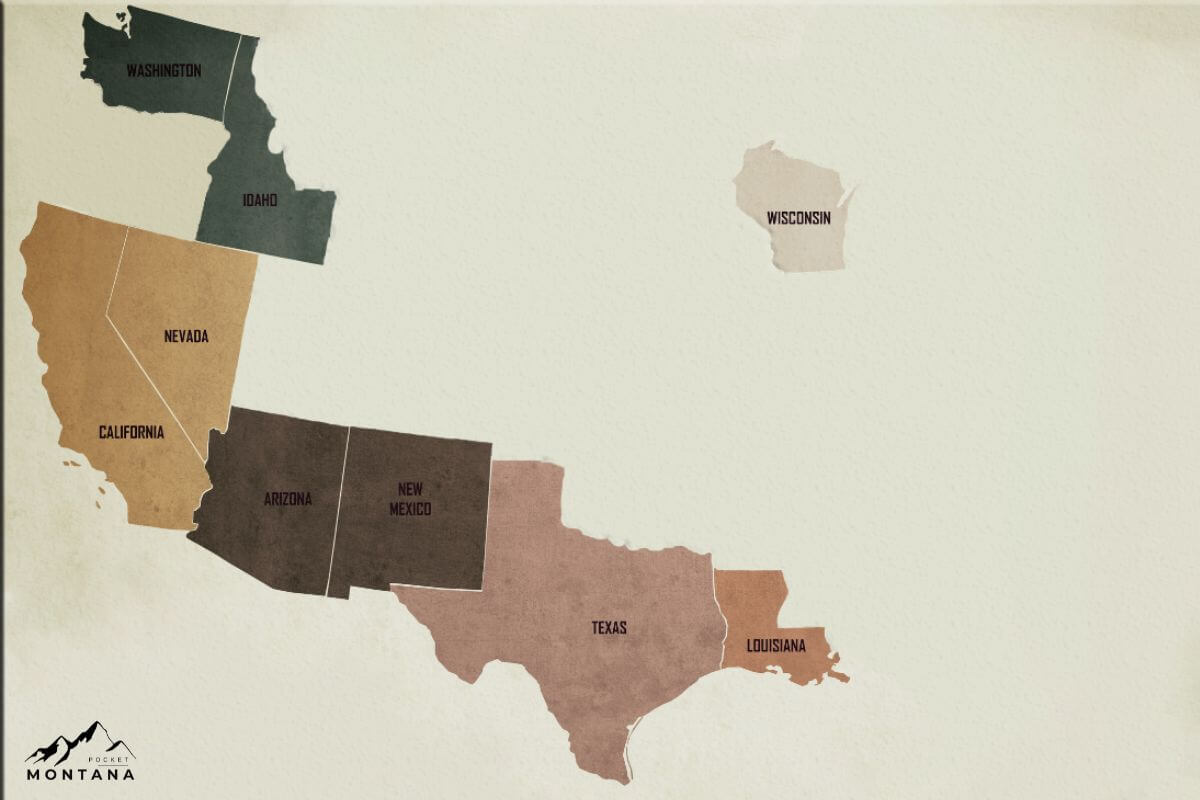Have you recently tied the knot or are considering doing so in Montana?
As someone who has researched and studied the state’s marital property laws, I can understand the confusion and uncertainties surrounding the topic.
Not to jinx your wonderful union but you may be wondering, is Montana a community property state? How will your assets be divided in case of a divorce?
In this article, I will address those questions and offer valuable insights that will ease your mind.
- Related article: Montana Laws to Know
Whether you are a newlywed or a longtime resident of Montana, this article is for you. Don’t let the complexities of marital property laws leave you feeling vulnerable and confused.
Let’s dive in and uncover the truth together.
Overview of Montana’s Marital Property Laws

When it comes to property division during divorce proceedings, there are specific rules that one needs to understand.
In Montana, the court follows the principle of equitable distribution when dividing marital property. It aims to distribute the assets and debts acquired during the marriage in a way that is fair and just, considering the unique circumstances of each case.
This means that, unlike community property states, property is not split equally, but rather in a way that is proportionate to each spouse’s contribution and needs.
Two types of property are usually taken into consideration: marital property and separate property.
Valuation of property is necessary as the court considers the value of marital assets before dividing them equitably. This is typically a complex process that involves appraisals to determine the fair market value of assets.
For instance, if a rental property increases in value over time, it necessitates a brand-new appraisal to determine its current actual worth.
When making decisions about property division, the court takes into account several factors which we will also tackle as we go along.
The court’s objective is to ensure that both spouses have a fair allotment of marital assets and debts, thus promoting financial independence and stability after divorce.
It may also be essential to understand the regulations on guns in Montana in connection with this, especially if firearms are part of your marital assets or there are safety concerns during the divorce process.
Marital Property vs Separate Property

Let’s take a look at some differences between marital and state property in detail:
| Marital Property | Separate Property | |
| Division of Property | Marital property is usually divided fairly between spouses during a divorce. However, in Montana, it is not necessarily divided equally. | Separate property is generally not subject to division during a divorce proceeding. |
| Assets Definition | Marital property includes assets acquired during the marriage such as real estate, bank accounts, vehicles, retirement accounts, and business interests. | Separate property refers to personal property such as assets that belong to one spouse alone, either before the marriage or acquired by gift, bequest, or devise during the marriage. |
| Inclusion of Debt | It also includes debt incurred during the marriage, regardless of the name on the account or who incurred it. | Separate property also includes separate debts acquired before marriage. |
It’s important to note that separate property in Montana may become marital property if it is commingled with marital property during a marriage or if a spouse’s efforts contribute to the increase in value of the separate property.
It’s essential to understand the rules and exceptions that apply to separate property in Montana to ensure that property division is carried out equitably.
Understanding what qualifies as separate property and how it may be affected
What Is a Community Property State?

Community Property State refers to a legal term that affects property division in the event of a divorce.
There are 9 states that qualify as community property states:
- Arizona
- California
- Idaho
- Louisiana
- Nevada
- New Mexico
- Texas
- Washington
- Wisconsin
The general principle of community property states that property acquired during a marriage is labeled as community property, regardless of which spouse bought it.
This means that both spouses have an equal ownership interest in the property, typically considered a 50-50 split. However, there are exceptions to community property laws that you need to be aware of.
For example, if you had a prenuptial agreement, any property outlined in the document would be treated separately from community property.
Similarly, if you inherited or bought a property before marriage, it would still belong to you as a separate property.
When it comes to divorce proceedings, community property laws can have significant implications.
If you are going through a divorce in a community property state, you must hire a divorce attorney who is familiar with these laws and can help you navigate the process.
Legal terms such as dissolution of marriage and fault divorce may also come into play, and it’s essential to understand what they mean and how they apply to your situation.
In the end, property rights and the division of assets are complex areas of the law, but understanding community property laws is an important step.
Whether you live in a community property state or not, knowing your legal rights and options is key in any divorce proceeding.
Equitable Distribution Law in Montana

Montana operates on an equitable distribution policy when it comes to divorce proceedings.
Equitable distribution doesn’t mean an equal distribution of property, but rather a fair and just distribution of assets based on various factors.
When a married couple can’t reach an agreement on how to divide their property, the court may intervene to divide the assets and liabilities.
The court has broad discretion in dividing the property, including joint property and separate funds, business interests, and sources of income accumulated during the marriage.
Factors like the length of the marriage, each party’s income, health, and future opportunities for the acquisition of capital assets and income are taken into consideration.
Even the issue of property and debt before marriage, the family house, and economic misconduct or marital misconduct may arise during the divorce process.
Ultimately, the goal of the court is to ensure a fair distribution of assets and liabilities based on the specific facts of the case.
Factors That Are Considered in Equitable Distribution

Equitable distribution is a way that assets and liabilities are divided between spouses in a divorce. However, it’s important to note that “equitable” does not necessarily mean “equal.”
Instead, the court will consider a wide range of factors to determine what is fair based on the individual circumstances of the case.
So, what are these factors? Well, they can vary depending on the specifics of the situation, but here are some examples of what might be taken into consideration:
- The length of the marriage – generally speaking, the longer the marriage, the more likely it is that assets will be divided equally.
- Age and health of each spouse – if one spouse is significantly older or has health problems, they may be entitled to a larger share of the assets in order to support themselves.
- Occupation and income of each spouse – if one spouse earns significantly more than the other, they may be entitled to a larger share of the assets.
- Skills and employability – if one spouse has sacrificed their career to care for children or support the other spouse’s career, they may be entitled to a larger share of the assets in order to retrain or support themselves.
- Liabilities – debts and other liabilities will also be taken into consideration when dividing assets.
- Care of children – if one spouse has been the primary caregiver for children, they may be entitled to a larger share of the assets in order to provide for the children’s needs.
- Premarital agreement: – if the couple had a premarital agreement in place that outlines property division, this will be taken into consideration.
- Custodial provisions – if custody of children is involved, the court will take into account the needs of the children when dividing assets.
- Medical decisions – if one spouse has significant medical needs, this may factor into the division of assets.
- Major decisions – if one spouse has made significant contributions to the marriage, such as paying for a spouse’s education or investing in a business, this may be taken into consideration.
It’s important to note that these factors are not an exhaustive list – every situation is unique, and the court will consider all relevant factors when making their decision.
Equitable distribution is intended to be a fair and just way of dividing property, and the court will do its best to make sure that each spouse is able to move forward after divorce with the resources they need.
What Is Spousal Maintenance?

Whether or not you saw it coming, separating your life from your spouse’s can be a challenging and emotional process, with financial and legal complications adding to the mix.
One complication driven by divorce is spousal maintenance, also known as alimony, which refers to the financial support provided by one spouse to the other after a divorce or legal separation.
The purpose of spousal maintenance in Montana is to help the recipient spouse maintain a standard of living similar to that enjoyed during the marriage and to assist in their transition to financial independence.
To determine if spousal maintenance is appropriate, the court will evaluate your financial need and your spouse’s ability to pay.
During the divorce process, each spouse will be required to disclose his or her financial information, including income, expenses, and assets.
This information will be used to determine whether a spouse has the ability to pay spousal maintenance and, if so, how much.
If a court determines that spousal maintenance is appropriate, it will also have to decide on the amount and duration of the payments.
Factors that may be considered for spousal maintenance include the following:
- Standard of living during the marriage
- The duration of the marriage
- Financial resources of each spouse
- Age and health of each spouse
Additionally, if the recipient’s spouse has a history of domestic violence, that may be taken into consideration as well.
It is important to understand that spousal maintenance is separate from the division of property.
While property is divided between the parties during a divorce, spousal maintenance is a separate issue that is addressed on a case-by-case basis.
In conclusion, Spousal maintenance is just one of those issues, and it is essential to understand how it works and how it may impact your financial future. By understanding the factors that a court will evaluate and the criteria that they will use to determine the amount and duration of spousal maintenance, you can be better prepared to navigate this aspect of the divorce process.
Montana’s Marital Property Law Final Thoughts

Divorce is never easy for anyone and the financial and legal issues that arise can be complex and difficult to navigate when you are not well-informed.
Montana is a state that generally follows equitable distribution when dividing property during a divorce.
This means that each spouse’s monetary and non-monetary contributions during the marriage will be taken into consideration, as well as other factors such as the length of the marriage and each spouse’s financial resources.
Also, because Montana is not a community property state, marital property is not automatically split 50/50 between spouses. Instead, property that is considered marital in nature will be divided in a fair and reasonable manner.
Spousal maintenance, on the other hand, is a separate issue from property division and is determined based on a variety of factors, including each spouse’s financial resources and the length of the marriage.
Overall, it is important for couples going through a divorce in Montana to understand their rights and the laws that apply to their specific situation.
Only when you are well-equipped with information or supported by the guidance of a knowledgeable divorce attorney, can you ensure a fair and equitable resolution for both parties.
Montana’s Marital Property Law Final FAQs
1. Is Montana a 50/50 State in Divorce?
No. Montana is not a 50/50 state. Instead, it follows the principle of equitable division, which means that property division is based on what is fair and reasonable under the specific circumstances of the case.
This takes into consideration several factors such as the length of marriage, age, and health of each spouse, as well as their income.
2. Who Gets What in a Divorce in Montana?
When it comes to a divorce in Montana, the division of property is handled through a fair and equitable process.
Marital assets along with liabilities incurred during the marriage are taken into account along with other key factors such as financial status and each spouse’s contribution.
3. Is Montana a Community Property State?
Unlike some other states, Montana is not a community property state. Instead, it follows a system of marital property laws that consider both community and non-marital property when determining property division during divorce. Montana’s property division laws are based on equitable distribution.
Did this article just stir up your curiosity about Montana? If you said yes, then check out these other cool articles:
- Gold Prospecting Laws in Montana
- Uncommon Montana Rules
- Concealed Carry Requirements in Montana
- Montana Alcohol Laws
- https://commons.und.edu/cgi/viewcontent.cgi?article=2225&context=ndlr
- https://leg.mt.gov/bills/mca/title_0400/chapter_0040/part_0020/section_0020/0400-0040-0020-0020.html
- https://chicagounbound.uchicago.edu/cgi/viewcontent.cgi?article=4316&context=uclrev
- https://leg.mt.gov/bills/mca/title_0400/chapter_0040/part_0020/section_0030/0400-0040-0020-0030.html
- https://scholarship.richmond.edu/cgi/viewcontent.cgi?article=1613&context=lawreview

